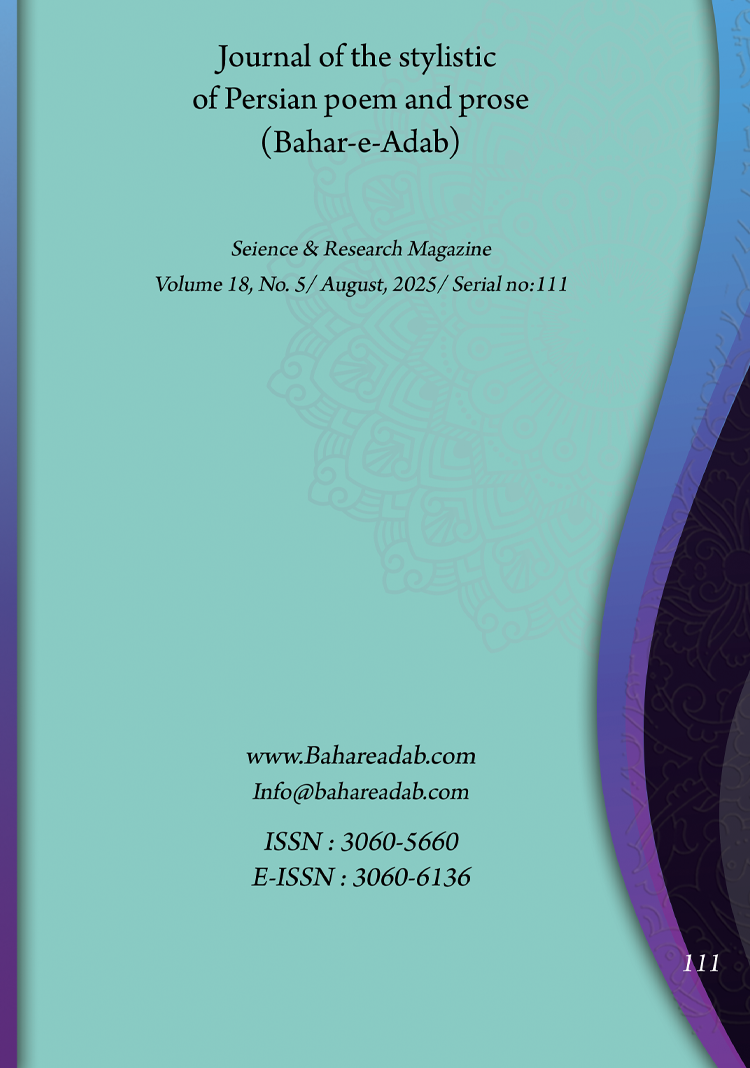- Count View : 13
- آدرس کوتاه شده مقاله: https://bahareadab.com/article_id/1853
- کد doi مقاله: Doi: 10.22034/bahareadab.2025 .18 .7873
Journal of the stylistic of Persian poem and prose
volume Number 18،
number In Volume 5،
،
issue Number 111
A study of the theory of the persuasive role of language in Parvin Etesami's poems.
Fatemeh Moradi (Author in Charge)
Abstract
BACKGROUND AND OBJECTIVES: One of the theorists of structuralism is "Roman Jakobson". His theory of verbal communication model is based on the fact that any communication between the speaker and the addressee is based on six factors: sender, receiver, communication channel, contact, code and subject. One of the communication roles in these six roles is the "persuasive role of language" in which the message is directed towards the addressee and the narrator tries to establish a connection with his addressee by using imperative and prohibitive sentences, quasi-sentences and exclamations. In Parvin Etesami"s Divan, the poet, by using numerous imperative and prohibitive sentences, exhorts the addressee to convey his message to him through linguistic tools and the persuasive role of language. The poet has used this method in various types of intransitive and transitive sentences of two, three and four parts and has used this method to express concepts with religious, mystical, cultural, political and social themes. Which indicates that in Parvin Etesami"s poetry collection, the use of persuasive methods in communicating with the audience is very effective.
METHODOLOGY: The research method in this article is descriptive-analytical based on library studies and writings related to Roman Jakobson’s structuralist theory and the communicative roles of language, especially the persuasive role of language. The statistical population of the research is Parvin Etesami"s poetry collection.
FINDINGS: The findings indicate that Parvin Etesami has used the persuasive role of language, which is one of the communicative roles in structuralist theory, to have a greater impact on the audience.
CONCLUSION: The poet of the didactic literature type, by using various methods of persuasive roles of language, including imperative and prohibitive sentences and making the audience the target, has added to the effect of her words and has encouraged the audience to accept the message of her poems. He has used the persuasive role of language in most concepts and themes such as: mystical-religious, cultural, and political-social, and his approach to his audience has been based more on the persuasive theory of language.
Keyword
Structuralism
, Jakobson’s theory
, persuasive role
, educational literature
, Parvin Etesami
- Ahmadi, Babak (2007). Text Structure and
- Interpretation. Ninth Edition. Tehran: Markaz.
- Scholes, Robert (1990). An Introduction to Structuralism in Literature. Translated by Farzaneh Taheri. First edition. Tehran: Agah
- Etesami, Parvin (2015). Parvin Etesami's Divan. Tehran: Shabahang
- Anvari, Hassan and Hassan Ahmadi Givi (1994). Persian Grammar Book 2. Tenth edition. Tehran: Fatemi Publishing House.
- Aghababaei, Somayeh Vasfavi and Iranzadeh (2016). Title of the article: Studying the structure of lyrical literature from a linguistic perspective based on the theory of "Jakobson's linguistic roles" Tehran: Literary Text Research
- Aghagolzadeh, Ferdows (2006). Critical Discourse Analysis. First edition. Tehran: Scientific and Cultural Publications.
- Batani, Mohammad Reza (1938). About Language. First edition. Tehran: Agah.
- Bateni, Mohammad Reza (1992). About Language and Linguistics. First edition. Tehran: Contemporary Culture.
- Tadié, Jean Yves (1938) Criticism in the Twentieth Century. Translated by Shirin No Nahali. Tehran: Niloufar
- Todorov, Tzvetan (2006). Literary Theory. Translated by Atefeh Tahaei. First edition. Tehran: Akhtaran.
- Rastegar Fasaei, Mansour and Atlas Esna Ashari (2005). Article title: Iranian Identity in Persian Literature until the Mongol Invasion. Journal of Humanities and Social Sciences, Shiraz University. Volume 22. Issue 1. Pages 69-80
- Sojoodi, Farzan (2001) Structuralism, Post-Structuralism and Literary Studies. Tehran: Islamic Propaganda Organization, Art Field.
- Samei Gilani, Ahmad (2004). Written and edited. Fifth edition. Tehran: Samt.
- Safavi, Kourosh (2001). From Linguistics to Literature. Volume 1. Second Edition. Tehran: Soore Mehr.
- Safavi, Kourosh (2004). From Linguistics to Literature. Volume 2. first Edition. Tehran: Soore Mehr.
- Faller, Roger et al. (1980), Linguistics and Literary Criticism. Translated by Maryam Khozan and Hossein Payande. Tehran: Ney.
- Farshidvard, Khosro (2003). Sentence and its transformation in Persian. Third edition. Tehran: Amir Kabir.
- Farshidvard, Khosro (2003). On Literature and Literary Criticism. Volume 2. Fourth Edition. Tehran: Amir Kabir.
- Kazazi, Mir Jalalalddin (1938). Aesthetics of Persian Speech 1st Edition. Tehran: Markaz
- Mahmoudi Bakhtiari, Ali Qoli (1999) The field of Iranian culture and civilization. Tehran: Offset Joint Stock Company.
- Vahidian Kamyar, Taqi (1990). The Tone of Speech in Persian. First Edition. Mashhad: Ferdowsi University.
- Vahidian Kamyar, Taqi (2004). How language becomes poetry. Title of the article: Discovering a reality about language. First edition. Mashhad: Islamic Azad University (Sokhan Gostar)
- Vafaei, Abbas Ali (2016). Persian Grammar. Tehran: Elmi.
- Hartmann, P. (1998). Linguistics and Literature. T. Brouché ... (others). Title of the article: Linguistics. Translated by Kourosh Safavi. First edition. Tehran: Hermes.
- Jakobson, Roman (2001) Structuralism, Poststructuralism and Literary Studies. De Saussure and Others. With the help of Farzan Sojoodi. Title of the article: Linguistics and Poetics. Translated by Kourosh Safavi. First edition. Tehran: Soore Mehr.
- Jakobson, Roman (2002). Linguistics and Literary Criticism. Roger Fowler and others. Article title: Linguistics and Poetics. Translated by Hossein Payande. Second edition. Tehran: Ney

